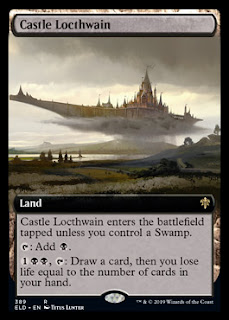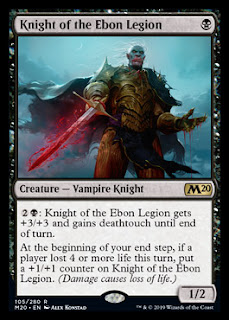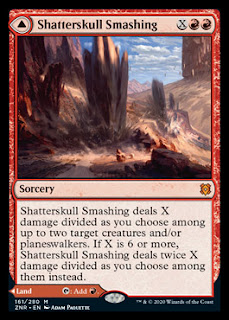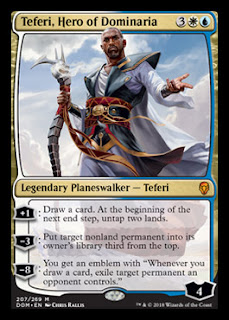Hardest part of writing a blog is thinking of Grateful Dead lyrics use for the title.
Anyways, Kaladesh comes out in a couple days and I just want to go over some stuff. I've been getting some good questions from folks on Reddit and Discord about Jund in general and the list moving forward, so I'll address some things that have been popping up.
On Chevill
Some folks ask about Chevill. I never really talked about Chevill in this blog because I just wasn't writing at the time when it was released and Chevill became a staple, to me, immediately, so it kind of didn't come up.
Personally, I saw Chevill in the spoiler and was hooked. I quite often get attached to a card and have to teach myself to let it go when it doesn't cut the mustard. This was not the case for Chevill. It overperformed from day 1 and I never looked back. I've played up to 4 and been happy with it.
The best analogy I can make to Chevill, at the same mana cost, would be something like Stoneforge Mystic with higher upside but a lower floor. We want to be killing our opponent's creatures anyways. Chevill offers us cards and life for this exchange, that you plan on doing like five times a game. It's not uncommon to be up five cards and 15 life for a 2 mana investment.
Chevill's floor is also really high. It's a 1/3 with deathtouch, which is already a huge pain in the ass for a lot of Historic decks. You can't really attack into it with anything that's the same mana cost or less, so usually your worst case scenario is your opponent has to take a turn off from casting threats to play a removal spell, or you trade with a more expensive creature. Being a good deal to trade off with helps negate the legend rule.
That's all well and good against aggro decks, which makes up a large part of the Historic format for what it's worth, but how about the rest of the field? Chevill doesn't attack especially well, but he doesn't need to. Trying to keep pace with the card advantage from stuff like Teferi and Narset used to be impossible, but if you're able to draw a card each time you Maelstrom Pulse or Bloodchief's Thirst an opposing Planeswalker, all of a sudden your removal spells are good instead of a liability. Also note that with Thoughtseize and Castle Locthwain in the deck, life gain is appreciated in matchups that normally would not need it.
I like Chevill a lot.
Cutting Red
I think there are plenty of arguments for cutting red. It may even be right to do so. This isn't great evidence or anything, but every time I do that, it doesn't feel right to me. Red cards offer the best cheap removal most of the time. In Modern this manifests as Lightning Bolt, Forked Bolt, Flame Slash, Terminate, and Dreadbore, but in Historic, Bloodchief's Thirst, Eliminate, Heartless Act, and now Fatal Push are probably the most efficient removal spells in the format. So we're sort of covered there, but I still like Abrade and Shivan Fire out of the sideboard. We also don't need to play Magmatic Channeler instead of the next best black or green value creature, and we don't need to play Chandra, Torch of Defiance instead of Vraska, Golgari Queen and Liliana, Waker of the Dead, but they are better.
My biggest gripes with the straight Golgari versions of this deck, though, is that the mana isn't that much better than with red. The cost of playing red isn't that you often miss a color, which happens but rarely, it's that you have to play lands that enter tapped or cause you damage. The mana requirements, even in Golgari, don't really allow for the use of colorless value lands, like Crawling Barrens.
I think Temple of Malady and maybe Field of Ruin if you're interested are the only big gains you get out of cutting Red, right now, and you lose out on efficiency. Jund feels like a sleeker, more efficient strategy to me, in basically every format I've tried it. If you feel different, then by all means, and you could very well be right. But I'm happy with the Red for now.
Kroxa
Patrick Chapin (I think) said that you never want to be a worse version of someone else. I played Kroxa in the past and it was good, but I don't think the deck is set up to utilize it very well right now with our Kazandu Mammoths, and I don't think the format is in a place where we can play Kroxa the fair way and make it work. Casting Kroxa for two mana isn't something I'm interested in while Burning Tree Emissary is legal. That's to say nothing of running into the graveyard trap and having our opponent's Rest in Peaces and Grafdigger's Cages and Scavenging Oozes do work against us. If you're willing to have graveyard hate be really good against you, then you should just play Rakdos Arcanist or Jund Sacrifice. Kroxa is certainly powerful and is good in matchups where we could admittedly use help, but I haven't missed it since I cut it from the deck a few months back. If you want to play with Kroxa, I'd suggest playing Elder Gargaroth or Glorybringer instead, which are huge creatures that have lots of impact on the board and actually cost less mana overall.
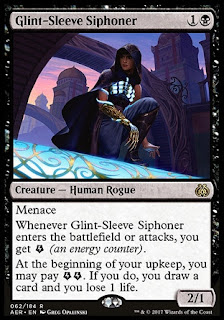
Glint-Sleeve Siphoner
This is a card that seems like it's perfect for this deck, and I'm definitely going to give it a try, but I don't have high hopes. I had someone in my twitch chat mention that they hope that Dark Confidant gets injected into Historic, and while I love Bob, it's not at the top of my wish list. Historic is fast, the aggro decks are really aggressive, the removal spells are cheap, your life total is taxed, and winning games comes down less often to how many cards you drew and more often how many cards you had time to cast. Remember that Dark Confidant in Modern is drawing you into stuff like Nihil Spellbomb and Damping Sphere and Anger of the Gods, whereas in Historic you'd be getting stuff like more copies of Maelstrom Pulse. Which is fine, but not always worth the cost of the undersized body that attacks your own life total.
Having said that, Siphoner is really good in conjunction with stuff like Attune with Aether and Winding Constrictor, and if you're headed down that road, there's Rogue Refiner and Confiscation Coup or Harnessed Lightning and Longtusk Cub. It's hard to say if the Energy package is going to be the way to go with midrange or not, but it sure was good while it was in Standard. I know I love my Chevills, but even I have a tipping point.
How's the Sultai Matchup?
It's good. Intrinsically it shouldn't be, but I've tested a lot of stuff out and have a plan that works. It wouldn't be good if Scavenging Ooze wasn't as good as it is. But not only do we play four Ooze, we also play three Inscription of Ruin to get it back. That said, it's really hard to play, plus they draw lots of cards and make lots of mana, and we aren't super fast. However, once we get into the late game, we're able to keep up on cards pretty well with our Planeswalkers, Inscription of Ruin, and Castle Locthwain, and I really like our sideboard plan. There are lots of games where you're like, "Aw, jeez, Uro again" and think you're screwed but you can sometimes just grind it out anyways.
How's the Blue/White Matchup?
It's ok. You need a lot of things to go right because their card advantage engines come online pretty fast if you stumble early, but you also need to have a sustained ability to present threats later on. It's totally doable though, and Castle Locthwain is extremely good because they don't pressure your life total hardly at all. We have a good sideboard plan and also don't necessarily need to walk into Wrath, so that's helpful. Each individual creature we present is good enough to essentially win the game by itself, so they all need to be dealt with. This is the matchup I'm looking to improve the most going forward, but Kaladesh might totally revamp the format, so who knows.
Now that the contents of Kaladesh are known, any changes to the deck?
This is the list I posted in the last post, a too-early-look at a post-Kaladesh Jund list. Since then the contents of the set were revealed, and nothing extremely out of the ordinary is in it, with some interesting little details.
No Felidar Guardian means we don't have to worry about Saheeli Rai combo. This makes it so we aren't pressured to play stuff like Eliminate or Bonecrusher Giant and hold up mana for it against control decks. Dedicated combo decks aren't that bad, and dedicated control decks aren't that bad, but decks that get to do both become real problems. Anyways, problem solved!
No Smuggler's Copter means that I'm even less incentivized to play Fatal Push over Bloodchief's Thirst. Heart of Kiran and Aethersphere Harvester will still exist, but they're slower and will be less prevalent. For what it's worth, I kind of like Smuggler's Copter being in the format, mostly because I don't see the downsides as downsides. The ubiquity amongst aggro decks, the low opportunity cost, the hard to deal with permanent type, not really that big of a deal to me, but I also like Umezawa's Jitte so I'm probably taking an L on this one.
No Walking Ballista means that the Forsaken Monument decks will not get better, which is good because that matchup is a nightmare for us. It also means that Winding Constrictor Energy decks won't be as prevalent and Whirler Virtuoso looks a little better. Outside of the Forsaken Monument decks, I'm not sure Ballista would have been a huge player in the format, but it's seeing play in stuff like Vintage all over the place so I'm probably wrong.
The inclusion of Aetherworks Marvel is scary, but we didn't have Grafdigger's Cage back when Marvel was first legal.
After everything, I don't think that there's anything I really want to change on day 1 of the set from the list I've posted, but this deck is definitely a work in progress, as is the whole format. I would imagine that a week from now it'll look quite a lot different, and I'll let you know then.
Why no Fatal Push?
I think that it's too inflexible, and we can't utilize the Revolt mechanic in this deck at all. Reid says that it's impossible to have a matchup that's
too good, but we're already beating up on aggro decks and lacking against control. It's certainly possible that I should have it in my sideboard over Shivan Fire and Disfigure, though. We'll see. I want to be clear that I don't think that Fatal Push is a bad card. Fatal Push is extremely good. During the Bolt vs Push debate when Push was printed, I played
this in Modern. It's very good, but Bloodchief's Thirst is also very good, and I think Thirst fits this deck and the format better.
Why not more Klothys?
I have to admit that Klothys is a card that I rejected for a long time but finally decided to give it a spin and now I'm wishing I had done it sooner. However, I've always been afraid to go above one copy, and that's because Klothys is uniquely hampered by its Legendary status. It's really hard to get this thing off the table, so it's really hard to make use of the second copy you draw. Is that cost worth adding another one or two? Possibly, but I feel pretty secure in my matchups where I desperately want this thing, so one has been good for me so far. Similarly, Radha is a legend rule trap herself, because she helps you dig into action so well that you're more likely to find yourself another copy of Radha. Anyways, if you want to take the risk and throw more copies of these two cards in, then go for it.
~
That's about it for me. Thanks a lot for reading, it's cool to see people get interested in an off-the-beaten-path style of deck. If you have more questions, I love talking about Jund probably even more than I love playing it, so feel free to comment here, harass me
@griffinzoth on twitter, or catch me in the r/mtgHistoric discord channel. Also
I stream on twitch and have a
Youtube page that I'm thinking about getting up and running again. See ya soon.

